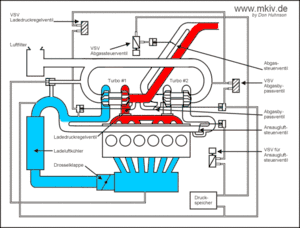Twin-turbo
Twin-turbo refers to an engine in which two turbochargers compress the intake fuel/air mixture (or intake air, in the case of a direct-injection engine). Also referred to dual power adders.
The most common layout features two identical turbochargers in parallel; other twin-turbo layouts include sequential and staged turbocharging.
Parallel
.jpg)
.jpg)
A parallel configuration refers to using two equally-sized turbochargers which each receive half of the exhaust gases.[1] Some designs combine the intake charge from each turbocharger into a single intake manifold, while others use a separate intake manifold for each turbocharger.
Parallel configurations are well suited to V6 and V8 engines since each turbocharger can be assigned to one cylinder bank, reducing the amount of exhaust piping needed. In this case, each turbocharger is fed exhaust gases by a separate exhaust manifold. For four-cylinder engines and straight-six engines, both turbochargers can be mounted to a single exhaust manifold.
The aim of using parallel twin-turbos is to reduce turbo lag by being able to use smaller turbochargers than if a single turbocharger was used for the engine. On engines with multiple cylinder banks (e.g. V engines and flat engines) use of parallel twin-turbos can also simplify the exhaust system.
The 1981-1994 Maserati Biturbo was the first production car to use twin-turbochargers.[2] The Biturbo used a 90-degree SOHC V6 engine with one turbocharger per cylinder bank.
Parallel configurations have also been used on engines with more than two turbochargers. One example is the 1991-1995 Bugatti EB110, which uses four turbochargers on its V12 engine. The 2005-2015 Bugatti Veyron uses four turbochargers— one per cylinder bank— on its W16 engine.
Sequential
Sequential turbocharging refer to a set-up in which the engine uses one turbocharger for lower engine speeds, and a second or both turbochargers at higher engine speeds.[3] This system is intended to overcome the limitation of large turbochargers providing insufficient boost at low RPM. On the other hand, smaller turbos are effective at low RPM (when there is less kinetic energy present in the exhaust gases) but are unable to provide the quantity of compressed intake gases required at higher RPM. Therefore, sequential turbocharger systems provide a way to decrease turbo lag without compromising power output at high RPM.
The system is arranged so that a small ("primary") turbocharger is active while the engine is operating at low RPM, which reduces the boost threshold (RPM at which effective boost is provided) and turbo lag. As RPM increases, a small amount of exhaust gas is fed to the larger ("secondary") turbocharger, to bring it up to operating speed. Then at high RPM, all of the exhaust gases are directed to the secondary turbocharger, so that it can provide the boost required by the engine at high RPM.[4]
The first production car to use sequential turbocharging was the 1986-1988 Porsche 959, which used sequential twin-turbos on its flat-six engine.[5][6] Sequential turbocharging can also be used with more than two turbochargers, such as in the 2012-2017 BMW N57S straight-six diesel engine, which uses three sequential turbos.[7]



Staged
Staged turbocharging (also called "serial turbocharging") is where the turbochargers are connected in series with the output of the first turbocharger then being further compressed by the second turbocharger.
A sequential turbo can also be of use to a system where the output pressure must be greater than can be provided by a single turbo, commonly called a staged twin-turbo system. In this case, multiple similarly sized turbochargers are used in sequence, but both operate constantly. The first turbo boosts provides the initial compression (for example to three times the intake pressure). Subsequent turbos take the charge from the previous stage and compress it further (for example to an additional three times intake pressure, for a total boost of nine times atmospheric pressure).
A downside of staged turbocharging is that it often leads to large amounts of turbo lag,[8] therefore it is mostly used on piston engine aircraft which usually do not need to rapidly raise and lower engine speed. (and thus where turbo lag is not a primary design consideration), and where the intake pressure is quite low due to low atmospheric pressure at altitude, requiring a very high pressure ratio. High-performance diesel engines also sometimes use this configuration,[9] since diesel engines do not suffer from pre-ignition issues and can therefore use high boost pressures.
See also
References
- "Twin-Turbocharging: How Does It Work?". www.carthrottle.com. Retrieved 4 October 2019.
- "Biturbo". www.maserati.com. Retrieved 5 October 2019.
- "How Compound Turbocharger Systems (Turbos) Work". www.axleaddict.com. Retrieved 4 October 2019.
- "1997 Toyota Supra - Prime Sequence". SuperStreetOnline. 27 May 2010. Retrieved 6 October 2019.
- "Video - The Porsche 959 is a $1.5 Million Automotive Icon". www.autotrader.com. Retrieved 6 October 2019.
- "Kimble Cutaway: Porsche 959". www.motor1.com. Retrieved 6 October 2019.
- "2013 BMW 750d xDrive Review". www.bmwblog.com. 29 March 2013. Retrieved 6 October 2019.
- "Twin-Turbocharging: How Does It Work?". www.carthrottle.com. Retrieved 8 October 2019.
- "Two Stage Serial Turbochargers for Diesel Engines". www.garrettmotion.com. Retrieved 8 October 2019.